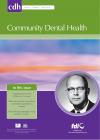Community Dental Health

- Cover Date:
- March 2010
- Print ISSN:
- 0265 539X
- Vol:
- 27
- Issue:
- 1
A study on neonatal factors and eruption time of primary teeth
Objective: The purpose of this study was to determine the time of the eruption of the first primary tooth (FPT) in infants and to assess the effects of neonatal factors on the timing of the eruption. Basic research design: The dental and medical records of healthy infants were reviewed to gather data on birth weight (BW), gestational age (GA), prenatal history, and the time of the eruption of the FPT. Additionally, the mothers of these infants were asked to identify their smoking habits and/or caffeine consumption during pregnancy through face-to-face interviews. The resulting data were statistically analysed with the Student’s t,Tukey, and Pearson correlation tests. Results: The mean eruption times (MET) for girls and boys were 7.25±2.47 and 7.07±1.66 months respectively (p>0.05). The MET of the FPT in infants with a GA of less than 34 weeks, 34 to 37 weeks, or over 37 weeks were 8.0±2.0, 8.29±2.97, 6.93±1.87 months, respectively. The MET in infants with a BW of 1500 to 2500g was 8.28 ±2.28 months, while the MET for the infants with a BW of over 2500g was 6.99±1.94 (p=0.014). Conclusion: A significant difference was found in the METs of infants with low and normal BWs. No significant differences were observed in the MET as related to other neonatal factors.
Keywords: Eruption time, neonatal factors, primary teeth.
- Article Price
- £15.00
- Institution Article Price
- £
- Page Start
- 52
- Page End
- 56
- Authors
- O. Aktoren, E.B. Tuna, Y. Guven, G. Gokcay
Articles from this issue
- Title
- Pg. Start
- Pg. End
- The influence of economic incentives on treatment patterns in a third-party funded dental service
- 18
- 22
- Is tooth wear in the primary dentition predictive of tooth wear in the permanent dentition? Report from a longitudinal study.
- 41
- 45
- Chewing stick use among African immigrants in West Philadelphia: implications for oral health providers
- 60
- 64
